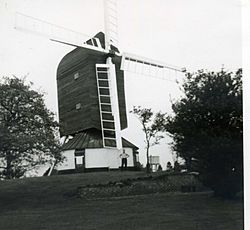Fryerning Mill facts for kids
Quick facts for kids Fryerning Mill |
|
|---|---|

Fryerning Mill in 1965
|
|
| Origin | |
| Mill name | Mill Green Mill |
| Grid reference | TL 640 008 |
| Coordinates | 51°40′52″N 0°22′16″E / 51.681°N 0.371°E |
| Operator(s) | Private |
| Year built | 1759 |
| Information | |
| Purpose | Corn mill |
| Type | Post mill |
| Roundhouse storeys | Single storey roundhouse |
| No. of sails | Four sails |
| Type of sails | Two Spring Patent sails and two Spring sails |
| Windshaft | Cast iron |
| Winding | Tailpole |
| No. of pairs of millstones | Two pairs |
| Size of millstones | Head stones 4 feet 6 inches (1.37 m), tail stones 4 feet (1.22 m) |
| Other information | Rebuilt 1959 |
Fryerning Mill, also known as Mill Green Mill, is a very old and important post mill located in Mill Green, Fryerning, Essex. It's a special building because it's been officially listed as a historic site (called a Grade II* listed building). This means it's been carefully saved and fixed up over the years.
Contents
The Mill's Story
This historic mill was built in 1759. It took the place of an even older mill that stood nearby from 1564 to 1731. A skilled builder named Robert Barker from Chelmsford constructed the mill. From the very beginning, it included a roundhouse at its base. The mill was owned by the Petre family, and their old records tell us about the money spent on keeping it running.
Important Events and Repairs
Over the years, the mill saw many changes and repairs. In 1802 and 1806, new sails were added to help it catch the wind. A new main support, called a stock, was fitted in 1821.
In 1852, there was an accident where the miller got hurt. The mill's roof was fixed in 1878, and the whole mill was re-tarred to protect the wood. More new sails were put on in 1884 and 1902. The mill continued to grind grain until at least 1905.
Restoration and Challenges
In the 1930s, some parts of the mill's main body were repaired. A big restoration happened in 1959. A man named R.F. Collinson bought the mill house and found the old mill in the garden. He decided to restore it. This huge job involved replacing almost the entire wooden frame of the mill, including a key part called the crowntree.
On January 2, 1976, a strong storm caused the sails to spin out of control. The brake wheel, which helps stop the sails, broke apart. A new brake wheel was built and installed in 1989, helping to keep the mill safe and sound.
How the Mill Works
Mill Green Mill is a type of post mill. This means its entire main body can turn to face the wind. It has a single-storey roundhouse at its base. The mill is turned into the wind using a long pole called a tailpole. It has four large sails: two are called spring sails, and two are spring patent sails. Inside, there are two pairs of millstones used for grinding grain.
The Base: Trestle and Roundhouse
The strong wooden frame at the bottom of the mill is called the trestle. It's made of oak wood. The main support post is thought to be made of sweet chestnut. The large horizontal beams, called crosstrees, are about 24 feet (7.3 meters) long. The main post itself is nearly 23 feet (7 meters) tall.
The roundhouse is built from brick. It has a roof covered in tarred felt, which helps protect the mill's base from the weather.
The Mill's Body
The main part of the mill, where the machinery is, measures about 15 feet (4.6 meters) by 11 feet (3.4 meters). A very important beam inside is the crowntree. It has a special metal plate bolted underneath it. This plate has a pin that fits into a metal pot on top of the main post, which is a unique way this mill was built.
Sails and Windshaft
When the mill was first built, it likely had a wooden windshaft and four simple sails. Today, the windshaft is made of cast iron. This long shaft, about 18 feet (5.5 meters) long, connects the sails to the gears inside. It holds the two main wheels that power the millstones. The mill has two spring sails and two spring patent sails, which together span about 58 feet (17.7 meters).
Inside Machinery
The mill has two main gears: the head wheel and the tail wheel. The head wheel is about 9 feet (2.7 meters) across. It has a metal ring with 120 teeth that connect to a smaller gear called a stone nut, which has 20 teeth. This system helps turn the millstones.
The tail wheel is about 7 feet (2.1 meters) across and has 100 teeth. It also drives a stone nut, which has 15 teeth. Both of these large wheels were made from elm wood. The headstones, which are the main grinding stones, are about 4 feet 6 inches (1.37 meters) in diameter. The tailstones are about 4 feet (1.2 meters) in diameter.
Millers of Fryerning Mill
Here are some of the people who worked as millers at Fryerning Mill:
- Dearman (from 1759)
- John Dearman (until 1852)
- Alfred Tuck (1855–1866)
- James Nicholls (1866–1899)
- Rankin (1899–1905)

